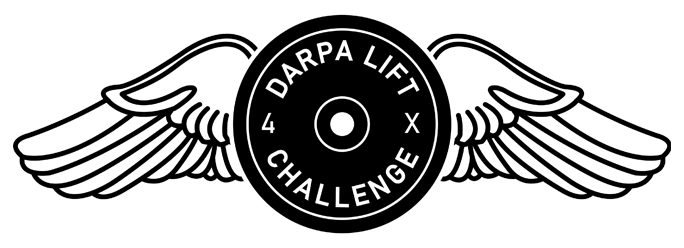Tapping Into the Core of American Innovation
The DARPA Lift Challenge taps into the core of American innovation: the ‘garage inventor’ spirit. Competitors must create an aircraft that is both lightweight and powerful.
To compete, designs must weigh no more than 55 pounds, including fuel or power source, and be capable of lifting a minimum payload of 110 pounds across the set 5-nautical mile circuit course. This threshold encourages creativity and innovative thinking for designs at a scale that should allow widespread participation.
The challenge prioritizes safety and regulatory compliance, requiring all participating individuals and teams to strictly adhere to Federal Aviation Administration (FAA) regulations. Teams will go head-to-head in live performance trials in Summer 2026.
These dates are generic, and specific dates will be announced here and the email distribution list.
Phase 1: Launch
October 2025:
- Special Notice publishing: DARPA publishes a Special Notice to broadly announce the Lift Challenge and solicit innovative design concepts.
- Website goes live: Official Challenge website launches, providing comprehensive information, eligibility criteria, and application details.
- Rules and prize announcement: Detailed rules and prize structure are announced, specifying objective and subjective judging criteria.
December 2025:
- Online Q&A: DARPA hosts online Q&A session(s) to address potential participants' questions and clarify challenge requirements.
Phase 2: Design and build
January 2026:
- Application period begins: DARPA begins accepting competition applications, allowing interested teams and individuals to officially request to participate in the competition.
- FAA certification submission: Teams begin to submit their pilot certification and as well as the experimental certification.
- Draft concept paper submission: Teams submit a draft concept paper outlining their proposed UAS design, technical approach, and key performance metrics for consistent engagement throughout design.
March 2026:
- Build progress picture submission: Teams will submit to DARPA progress picture and videos of the building of their aircraft to ensure consistent engagement.
May 2026:
- Flight test verification: Teams will submit pictures and videos to demonstrate the performance and safety of the UAV.
- Final concept paper submission: Testing is complete and analysis and information are ready for review.
- FAA certification approval: All FAA certifications must be approved in Phase 2 prior to formal team invitation to compete.
- Application period closed
Phase 3: Competition & Evaluation
June 2026:
- Formal team invitation to compete: All teams have completed any pre-qualifications needed at this point for their design. DARPA will formally invite teams that have met all eligibility requirements and announce challenge schedule to include assigned flight windows.
- Weigh-in and inspection: A comprehensive weigh-in and systems inspection process will take place to document the details of the aircraft.
- Challenge run through: Teams will compete across multiple flight windows to achieve an eligible score. The highest score of the flight window will be submitted for review at the end of each flight window. The highest overall score for a team will be maintained throughout the competition.
- Challenge completion: The challenge week concludes with an awards ceremony recognizing the top performers in both objective and subjective categories. A panel of DARPA experts will judge the final subjective winners for the competition.
To be eligible to receive prize money, the Lift Challenge requires registrants' Social Security Number (SSN) or Taxpayer Identification Number (TIN). See Rules for additional eligibility requirements.
Objective categories
Overall Payload-to-Weight Ratio
This is the primary metric, with prizes awarded to first ($2.5M), second ($1.5M), and third ($1M) place.
- Measurement: Payload and aircraft weight in pounds (lbs), as measured by a certified and calibrated scale. The scale must have a resolution of at least 0.1 lbs (0.045 kg).
- Scoring: The primary metric is the maximum payload weight divided by the aircraft weight. In the event of a tie, the team with the highest payload weight will be declared the winner. If a tie persists, the team with the fastest time will be declared the winner. Each team will be evaluated based on its ‘most successful’ singular run across all of its attempts. Please note score signifies payload weight (lbs) / aircraft weight (lbs).
- Verification: DARPA representative will weigh the aircraft and payload right before flight.
- Payload requirement: Teams must meet a minimum of 110 lbs payload and follow the course rules for score consideration. The top three teams will receive the full prize award if they are above the 4:1 ratio. If they are below the 4:1 ratio, the team will receive 50% of the prize award.
Subjective categories
These categories will be judged by a panel of DARPA experts and will be based on a combination of technical merit, innovation, and potential impact.
- Most Revolutionary Aerodynamic Design ($500,000)
Evaluation Criteria: Novelty of the design, potential for improved performance (e.g., lift, drag, stability), and feasibility of operation.
- Most Revolutionary Powertrain Design ($500,000)
Evaluation Criteria: Novelty of the propulsion system, potential for improved efficiency, reliability, and scalability.
- Most Promising ($500,000)
Evaluation Criteria: Overall potential of the design to meet customer’s needs, considering factors such as cost, performance, scalability, usability, and transition potential.
Eligibility
- Intent to compete: Individuals and teams must attempt to complete the course, high performance and completion of the course is desired but not required to be eligible for this prize category.
Example: You have a novel design, but crashed on takeoff.
- A team who wins an objective category can also be eligible for one or more subjective categories.


